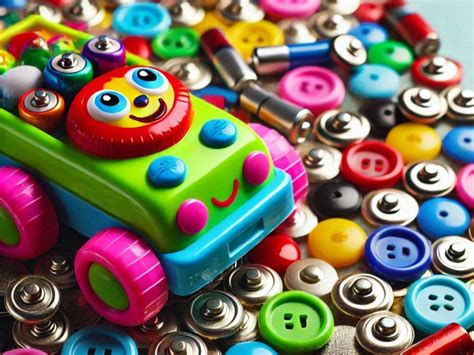
A mother is sharing her toddler’s harrowing two-year recovery after the 18-month-old swallowed a button battery, highlighting the dangers of these ubiquitous household items and the long-term consequences they can have on young children.
Katie Ricks, from Chicago, experienced every parent’s nightmare when her then 18-month-old daughter, Eloise, ingested a button battery in March 2022. What followed was a frantic rush to the emergency room, multiple surgeries, and a prolonged recovery that continues to this day. The ordeal has led Ricks to become a vocal advocate for increased awareness of button battery dangers and improved safety measures.
Eloise’s ordeal began when Ricks found her daughter unusually quiet. A quick search revealed the back of a remote control was open and the button battery was missing. Recognizing the immediate danger, Ricks rushed Eloise to the emergency room, where an X-ray confirmed the battery’s presence in her esophagus.
“We were really lucky that I found her as quickly as I did,” Ricks told Yahoo Lifestyle.
The severity of button battery ingestion lies in the chemical reaction that occurs when the battery comes into contact with the body’s moist tissues. The battery creates an electrical current that electrolyzes saliva, breaking it down into hydrogen and hydroxide. The hydroxide causes a rapid and severe alkaline burn, which can damage tissue within just two hours. In Eloise’s case, the battery caused significant damage to her esophagus, leading to a tracheoesophageal fistula (TEF), an abnormal connection between the trachea and the esophagus.
Doctors were able to remove the battery, but the damage was already done. Eloise underwent multiple surgeries to repair her esophagus and trachea. She spent weeks in the hospital, initially unable to eat or drink normally, relying on a feeding tube for nutrition. The TEF caused food and liquids to enter her lungs, leading to repeated bouts of pneumonia and further complications.
The recovery process has been long and arduous. Eloise has required ongoing speech therapy, occupational therapy, and regular medical check-ups. While she is now able to eat and drink, she still faces challenges and may require additional surgeries in the future. Ricks emphasizes the lasting impact the incident has had on Eloise’s life and the family’s overall well-being.
Ricks is now actively involved in raising awareness about the dangers of button batteries. She shares her family’s story on social media and advocates for safer battery designs and packaging. She hopes that by sharing her experience, she can prevent other families from going through the same ordeal.
Button batteries are found in a wide range of household devices, including remote controls, toys, watches, hearing aids, and calculators. Their small size and appealing shape make them attractive to young children, who may mistake them for candy or small toys.
Organizations like the National Safety Council and the American Academy of Pediatrics have launched campaigns to educate parents and caregivers about the dangers of button batteries. These campaigns emphasize the importance of keeping button batteries out of reach of children, securing battery compartments in devices, and properly disposing of used batteries.
The case of Eloise Ricks underscores the urgent need for increased awareness and preventative measures to protect children from button battery ingestion. The long-term consequences can be devastating, highlighting the importance of proactive safety measures in every household.
In-Depth Analysis:
The Eloise Ricks case is a stark reminder of the hidden dangers lurking in seemingly innocuous household items. Button batteries, while essential for powering numerous devices, pose a significant risk to young children due to their size, accessibility, and the severe chemical burns they can inflict upon ingestion. This incident isn’t an isolated one; emergency rooms across the country see a steady stream of cases involving children who have swallowed button batteries, often with life-altering consequences.
The severity of the damage caused by button batteries is disproportionate to their small size. When a button battery comes into contact with moist tissues, such as the lining of the esophagus, it creates an electrical circuit. This process, known as electrolysis, breaks down water molecules into hydrogen and hydroxide ions. The hydroxide ions are highly alkaline and cause a rapid and severe chemical burn, liquefying tissue within a matter of hours. This is distinct from the damage caused by other swallowed objects, which typically result in physical obstruction or irritation. The alkaline burn from a button battery can lead to perforations, fistulas (abnormal connections between organs), and long-term scarring that can affect breathing, swallowing, and overall development.
Eloise’s tracheoesophageal fistula (TEF) is a particularly devastating complication. The TEF created an abnormal connection between her trachea (windpipe) and esophagus (food pipe). This meant that when she ate or drank, food and liquids could leak into her lungs, leading to aspiration pneumonia, a serious and potentially life-threatening condition. Correcting a TEF often requires multiple surgeries and can leave lasting damage to the delicate structures of the airway and digestive tract.
The long-term impact on Eloise’s development is another critical aspect of this case. The need for feeding tubes, repeated hospitalizations, and ongoing therapies (speech, occupational, and physical) can disrupt a child’s normal development trajectory. Difficulty eating can lead to nutritional deficiencies, while repeated illnesses can weaken the immune system. The trauma of the experience can also have emotional and psychological effects on both the child and the family.
Katie Ricks’ decision to share her family’s story is a powerful form of advocacy. By raising awareness about the dangers of button batteries, she hopes to prevent other families from experiencing the same trauma. Her advocacy efforts are particularly important because many parents are unaware of the risks associated with button batteries and may not take adequate precautions.
The response to the button battery crisis has been multifaceted. Organizations like the National Safety Council, the American Academy of Pediatrics, and the Consumer Product Safety Commission (CPSC) have launched public awareness campaigns, developed educational materials, and advocated for stricter safety standards. These efforts focus on several key areas:
- Education: Informing parents and caregivers about the dangers of button batteries, how to identify potential hazards, and what to do in case of ingestion.
- Prevention: Encouraging the use of devices with secure battery compartments that require a tool (like a screwdriver) to open. Promoting the proper storage and disposal of button batteries.
- Product Safety: Advocating for the development and implementation of safer battery designs, such as coating the batteries with a bitter-tasting substance to deter ingestion or using tamper-resistant packaging.
- Medical Response: Improving protocols for the rapid diagnosis and treatment of button battery ingestion, including the use of X-rays to confirm the battery’s location and the prompt removal of the battery by trained medical professionals.
Despite these efforts, challenges remain. Button batteries are ubiquitous, and it is impossible to eliminate the risk entirely. The accessibility of button batteries in everyday devices makes constant vigilance essential. Furthermore, the relatively low cost of button batteries can incentivize manufacturers to prioritize affordability over safety.
The legislative landscape is also evolving. Several states have passed laws requiring child-resistant packaging for button batteries, and there is growing support for a federal standard mandating such packaging nationwide. There is also a push to develop and promote the use of safer battery chemistries that are less likely to cause severe burns if ingested.
The Eloise Ricks case highlights the critical need for a multi-pronged approach to address the button battery crisis. This includes increased public awareness, stricter safety standards, improved medical protocols, and ongoing research into safer battery technologies. By working together, parents, manufacturers, policymakers, and healthcare professionals can help protect children from the devastating consequences of button battery ingestion.
The Chemical Reaction in Detail:
The mechanism behind the tissue damage caused by button batteries is critical to understanding the severity of the risk. As mentioned, the process involves electrolysis. When the battery comes into contact with saliva or other moist tissues, it creates a closed electrical circuit. The negative pole (cathode) of the battery attracts positively charged ions in the surrounding fluid, while the positive pole (anode) attracts negatively charged ions.
The key reaction occurs at the cathode, where water molecules (H2O) are broken down into hydrogen gas (H2) and hydroxide ions (OH-). The hydroxide ions are highly alkaline and cause a liquefactive necrosis, essentially dissolving the tissue they come into contact with. This process is extremely rapid, and significant damage can occur within as little as two hours.
The severity of the burn depends on several factors, including:
- Battery Size and Voltage: Larger batteries and batteries with higher voltages generate a stronger electrical current and cause more rapid tissue damage.
- Location of the Battery: The esophagus is particularly vulnerable because it is a narrow passageway with a moist lining. Batteries lodged in the esophagus are more likely to cause severe burns than batteries that pass quickly through the digestive tract.
- Duration of Contact: The longer the battery remains in contact with the tissue, the more extensive the damage will be.
- Battery Chemistry: Lithium batteries, which are increasingly common, tend to cause more severe burns than alkaline batteries.
In addition to the alkaline burn, the battery can also cause pressure necrosis. The physical pressure of the battery against the tissue can restrict blood flow, leading to cell death and tissue damage. This is particularly problematic in the esophagus, where the tissue is relatively thin and delicate.
Medical Management and Treatment:
The medical management of button battery ingestion depends on the location of the battery and the severity of the symptoms. The initial step is typically an X-ray to confirm the battery’s location. If the battery is lodged in the esophagus, it must be removed immediately.
The preferred method for removing a button battery from the esophagus is endoscopy. This involves inserting a flexible tube with a camera and instruments attached into the esophagus to visualize and remove the battery. In some cases, surgery may be necessary.
After the battery is removed, the damaged tissue is carefully examined. The treatment may include:
- Medications: Antibiotics to prevent infection, steroids to reduce inflammation, and pain relievers to manage discomfort.
- Nutritional Support: A feeding tube may be necessary if the patient is unable to eat or drink normally.
- Surgery: Surgery may be required to repair perforations, fistulas, or other damage to the esophagus or trachea.
- Speech Therapy: Speech therapy can help patients regain their ability to swallow and speak normally.
- Occupational Therapy: Occupational therapy can help patients regain fine motor skills and coordination.
Long-term follow-up is essential to monitor for complications such as esophageal strictures (narrowing of the esophagus), recurrent fistulas, and swallowing difficulties.
Prevention Strategies in Detail:
Given the potential for severe and life-altering consequences, prevention is paramount. A comprehensive prevention strategy involves multiple layers of protection:
-
Secure Battery Compartments: This is the most effective way to prevent children from accessing button batteries. Devices should be designed with battery compartments that require a tool, such as a screwdriver or coin, to open. Manufacturers should also ensure that battery compartments are securely fastened and cannot be easily pried open.
-
Child-Resistant Packaging: Button batteries should be packaged in child-resistant packaging that is difficult for young children to open. This can include blister packs, resealable pouches, or other types of packaging that require significant dexterity and strength to access.
-
Proper Storage: Button batteries should be stored in a safe place out of reach of children. This could be a locked cabinet, a high shelf, or a container with a child-resistant lid.
-
Safe Disposal: Used button batteries should be disposed of properly. They should not be thrown in the trash, as they can still pose a risk to children who may find them. Instead, they should be recycled or disposed of at a designated collection site. Many communities offer battery recycling programs, and retailers that sell button batteries may also offer take-back programs.
-
Product Redesign: Manufacturers should explore alternative battery designs that are less hazardous if ingested. This could include coating the batteries with a bitter-tasting substance to deter ingestion, using tamper-resistant packaging, or developing batteries with a lower voltage.
-
Education and Awareness: Public awareness campaigns should be targeted at parents, caregivers, and healthcare professionals. These campaigns should emphasize the dangers of button batteries, how to prevent ingestion, and what to do in case of ingestion. Educational materials should be available in multiple languages and formats to reach a wide audience.
-
Legislation and Regulation: Governments should consider enacting legislation and regulations to mandate child-resistant packaging for button batteries, require secure battery compartments in devices, and promote the development of safer battery technologies.
The Role of Healthcare Professionals:
Healthcare professionals play a crucial role in preventing and managing button battery ingestion. They should:
-
Educate Parents: Healthcare providers should educate parents about the dangers of button batteries during routine check-ups and well-child visits. They should provide information on how to prevent ingestion and what to do in case of ingestion.
-
Recognize Symptoms: Healthcare providers should be aware of the symptoms of button battery ingestion, which can include drooling, coughing, choking, vomiting, chest pain, abdominal pain, and difficulty breathing.
-
Prompt Diagnosis and Treatment: Healthcare providers should promptly diagnose and treat button battery ingestion. This includes obtaining an X-ray to confirm the battery’s location and removing the battery as quickly as possible.
-
Long-Term Follow-Up: Healthcare providers should provide long-term follow-up to monitor for complications such as esophageal strictures, recurrent fistulas, and swallowing difficulties.
The Future of Button Battery Safety:
The future of button battery safety will likely involve a combination of technological innovation, regulatory action, and public awareness efforts.
-
Safer Battery Chemistries: Research is underway to develop safer battery chemistries that are less likely to cause severe burns if ingested. One promising approach is the use of zinc-air batteries, which are less corrosive than lithium batteries.
-
Smart Batteries: Smart batteries could be designed to detect when they have been ingested and trigger an alert to parents or healthcare providers. They could also be designed to deactivate themselves once they have been ingested, reducing the risk of tissue damage.
-
Improved Packaging: Packaging technology is constantly evolving, and there is potential to develop even more effective child-resistant packaging for button batteries.
-
Enhanced Regulation: Governments could enact stricter regulations to mandate child-resistant packaging, require secure battery compartments, and promote the development of safer battery technologies.
-
Continuing Education: Ongoing education and awareness campaigns will be essential to ensure that parents, caregivers, and healthcare professionals are aware of the dangers of button batteries and how to prevent ingestion.
The Eloise Ricks case serves as a powerful reminder of the importance of vigilance and prevention when it comes to button battery safety. By working together, we can help protect children from the devastating consequences of button battery ingestion.
Frequently Asked Questions (FAQ):
1. What are button batteries and where are they commonly found?
Button batteries are small, round batteries that are used to power a variety of electronic devices. They are commonly found in items such as remote controls, toys, watches, hearing aids, calculators, key fobs, thermometers, and even some greeting cards and books. Their small size and shiny appearance can make them attractive to young children, who may mistake them for candy or small toys.
2. What are the dangers of swallowing a button battery?
Swallowing a button battery can be extremely dangerous, especially for young children. When a button battery comes into contact with moist tissues like the lining of the esophagus (the tube that connects the mouth to the stomach), it creates an electrical current. This electrical current breaks down water molecules and produces hydroxide, a highly alkaline substance that causes a severe chemical burn. This burn can damage the esophagus within just two hours, leading to serious complications such as perforations, fistulas (abnormal connections between organs), and long-term scarring. In addition to the chemical burn, the battery can also cause pressure necrosis, where the pressure of the battery against the tissue restricts blood flow, leading to cell death.
3. What should I do if I suspect my child has swallowed a button battery?
If you suspect that your child has swallowed a button battery, it is crucial to act immediately. Do not induce vomiting or give the child anything to eat or drink. Call the National Battery Ingestion Hotline at 800-498-8666 for immediate guidance. Then, take your child to the nearest emergency room as quickly as possible. Inform the medical staff that you suspect button battery ingestion. Time is of the essence, as the longer the battery remains in the esophagus, the greater the risk of serious damage.
4. How can I prevent my child from swallowing a button battery?
Preventing button battery ingestion requires a multi-faceted approach:
- Secure Battery Compartments: Ensure that all devices containing button batteries have secure battery compartments that require a tool (like a screwdriver) to open. Regularly check these compartments to make sure they are properly closed and cannot be easily pried open.
- Child-Resistant Packaging: Purchase button batteries that come in child-resistant packaging, which is designed to be difficult for young children to open.
- Proper Storage: Store loose button batteries in a safe place out of reach of children, such as a locked cabinet, a high shelf, or a container with a child-resistant lid.
- Safe Disposal: Dispose of used button batteries properly by recycling them or taking them to a designated collection site. Do not throw them in the trash, as they can still pose a risk to children who may find them.
- Education: Educate older children about the dangers of button batteries and instruct them not to handle them or give them to younger siblings.
5. What kind of long-term complications can result from button battery ingestion?
The long-term complications of button battery ingestion can be severe and life-altering, depending on the extent of the damage to the esophagus and other surrounding tissues. Some potential long-term complications include:
- Esophageal Strictures: Narrowing of the esophagus due to scarring, which can make it difficult to swallow.
- Tracheoesophageal Fistula (TEF): An abnormal connection between the trachea (windpipe) and the esophagus, which can cause food and liquids to enter the lungs, leading to aspiration pneumonia.
- Vocal Cord Paralysis: Damage to the nerves that control the vocal cords, which can affect speech and breathing.
- Swallowing Difficulties (Dysphagia): Difficulty swallowing due to damage to the muscles and nerves involved in the swallowing process.
- Feeding Difficulties: The need for feeding tubes to provide adequate nutrition if the child is unable to eat or drink normally.
- Respiratory Problems: Chronic respiratory problems due to repeated aspiration pneumonia or damage to the airway.
- Developmental Delays: Developmental delays due to the prolonged hospitalizations, surgeries, and therapies required for recovery.
- Psychological Trauma: Emotional and psychological trauma for both the child and the family due to the traumatic experience of button battery ingestion and its aftermath.









